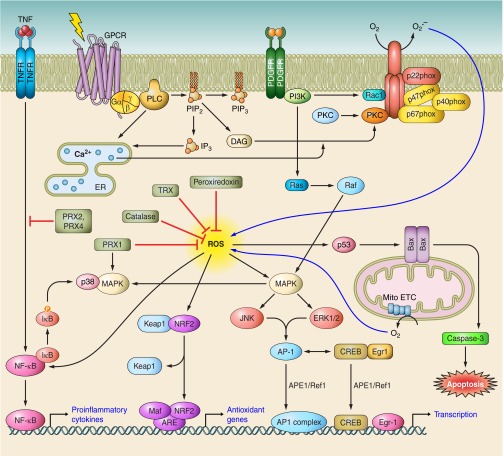FIGURE 4.
Schematic depiction of multiple signaling pathways that generate ROS and the intracellular events activated by ROS accumulation. Upon activation, G protein-coupled receptors (GPCRs) activate phospholipase C (PLC) leading to the activation of protein kinase C (PKC) molecules. Platelet-derived growth factor receptors (PDGFRs) activate phosphoinositide 3-kinase leading to activation of ras-related C3 botulinum toxin substrate 1 (RAC1). Both RAC1 and PKC activate membrane-bound receptors leading to membrane relocation and assembly of various components of phagocytic NADPH oxidases. Mitochondrial electron transport chain (mito ETC) is another robust source of intracellular ROS generation. ROS in turn lead to enhanced production of (APE1/Ref1) and activation of several signaling events including p53-mediated apoptotic events, mitogen-activated protein kinase (MAPK) pathways, NF-E2-related factor (NRF2)-mediated activation of genes containing antioxidant response element (ARE), and nuclear factor-κB (NF-κB). Transcription factors including AP1, NF-κB, cAMP response element-binding (CREB), and early growth response (EGR) protein, induced by these signaling events are kept in the active and reduced form by APE1/Ref1. Thus ROS signaling events play a central role in regulation of proinflammatory events, cell cycle, proliferation, and cell death. Antioxidant defense enzymes such as catalase, thioredoxins (TRX), peroxidases, and peroxiredoxins (PRX) contribute to preventing excessive levels of ROS from accumulating at the cellular and tissue level.

